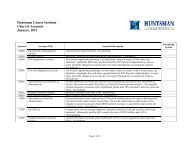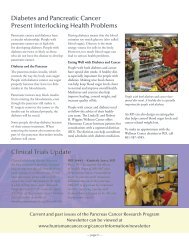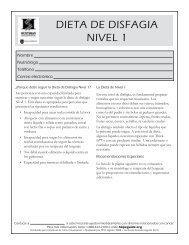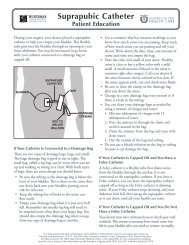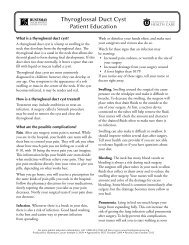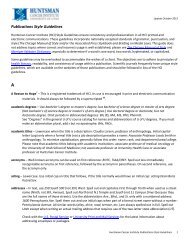Cancer Program AR - Huntsman Cancer Institute - University of Utah
Cancer Program AR - Huntsman Cancer Institute - University of Utah
Cancer Program AR - Huntsman Cancer Institute - University of Utah
- No tags were found...
You also want an ePaper? Increase the reach of your titles
YUMPU automatically turns print PDFs into web optimized ePapers that Google loves.
<strong>University</strong> <strong>of</strong> <strong>Utah</strong> Hospitals & Clinics<strong>Cancer</strong> <strong>Program</strong>2000 ANNUAL REPORT
TABLE OF CONTENTS 2 <strong>University</strong> <strong>of</strong> <strong>Utah</strong> Hospitals and Clinics <strong>Cancer</strong> Committee Members3 <strong>Cancer</strong> Cases6 <strong>Cancer</strong> Registry Report7 Study Request Log8 <strong>Cancer</strong> Conferences10 <strong>Program</strong> Development12 PET Scanner13 New Faculty14 Patient Support Groups14 Volunteer <strong>Program</strong>14 Pain Medicine and Palliative Care <strong>Program</strong>15 Clinical Research17 Developing the Future Generation <strong>of</strong> Oncology Nurses17 Education, Prevention, and Outreach18 Community Services21 Primary Intracranial/CNS Tumors PCE Study
<strong>University</strong> <strong>of</strong> <strong>Utah</strong> Hospitals & Clinicschairman’s letterThe cancer program at the <strong>University</strong> <strong>of</strong> <strong>Utah</strong> Health Sciences Center is a unique collaboration <strong>of</strong> programsdedicated to improving cancer care for patients in <strong>Utah</strong> and the Intermountain West. As the premier teachinghospital and referral center for this area, it helps set the standard for care as well as providing for the education<strong>of</strong> the next generation <strong>of</strong> physicians, nurses, pharmacists, and medical researchers. In the past year, the combinedefforts <strong>of</strong> the <strong>University</strong> <strong>of</strong> <strong>Utah</strong> Hospital and the <strong>Huntsman</strong> <strong>Cancer</strong> <strong>Institute</strong> have created an environment thatpromotes improvement in every aspect <strong>of</strong> cancer care. New clinical space, a first-class learning center, specialtytumor boards, and investments in new technology highlight the most recent changes in our program. Fundingfor a new cancer research hospital has been secured and the design and construction processes are underway.The demographic shift to an older population in <strong>Utah</strong> increases the importance <strong>of</strong> cancer as a public healthproblem. Currently, about 6,000 <strong>Utah</strong>ns are newly diagnosed and 2,500 will die <strong>of</strong> cancer each year. The cancerprogram at the <strong>University</strong> <strong>of</strong> <strong>Utah</strong> has a unique responsibility and opportunity to serve the citizens <strong>of</strong> <strong>Utah</strong> andthe Intermountain West by continuously improving programs that aggressively address this most feared anddevastating disease. Innovative breakthroughs in genetics, immunology, and biotechnology hold the promise <strong>of</strong>dramatic changes in how cancer is prevented and treated. The <strong>Huntsman</strong> <strong>Cancer</strong> <strong>Institute</strong> is a leader in cancerresearch and continues to devote significant resources to research, education, and patient care.On behalf <strong>of</strong> the <strong>Cancer</strong> Committee, I wish to thank Dr. Saundra Buys for her exceptional leadership <strong>of</strong> the<strong>Cancer</strong> Committee the past three years. She has guided the committee through a period <strong>of</strong> significant changeand continually sets the example <strong>of</strong> how to provide compassionate care. We have a superb committee <strong>of</strong> dedicatedpeople who all share the vision <strong>of</strong> providing the best care available to our patients. I look forward toanother year <strong>of</strong> progress and success with our cancer program.Sean Mulvihill, M.D.Chair, <strong>Cancer</strong> Committee
<strong>University</strong> <strong>of</strong> <strong>Utah</strong> Hospitals & Clinicsuniversity <strong>of</strong> utah hospitals and clinicscancer committee membersMadeline Buelt, MSNSaundra Buys, MDMichele Dabrowski, LCSWMark Dodson, MDRosemary Field, RNKristine Gilbert, RN, CPHQGina Gregovich, CCRPAnne M. Kennedy, MDDiane Kiuhara, MS, RN, OCNLester Layfield, MDSean Mulvihill, MD, ChairSandra Reay, CTRVaughn Roche, LCSWKim A. Segal, MPH/HSAScott Silverstein, R.Ph, M.S.Jennifer SmithTanya SmithJohn Speed, MDBen TannerAl TokunagaGordon Watson, MD, Liaison PhysicianAdministrationOncology, HCISocial ServicesGynecologic OncologyNursing PracticePM&IClinical TrialsDiagnostic RadiologyNurse ManagerPathologySurgery<strong>Cancer</strong> RegistrySocial ServicesPain Medicine & Palliative Care <strong>Program</strong>Pharmacy<strong>Cancer</strong> Registry<strong>Cancer</strong> Learning CenterPhysical Medicine & RehabDirector, Oncology ServicesDirector, Health InformationRadiation Oncology2 <strong>Cancer</strong> <strong>Program</strong>
<strong>University</strong> <strong>of</strong> <strong>Utah</strong> Hospitals & Clinics2000 cancer casestotal cancer cases: 1,786Class <strong>of</strong>Case Total Explanation0 31 Diagnosed at <strong>University</strong> <strong>of</strong> <strong>Utah</strong>, treated elsewhere1 523 Diagnosed/1st course <strong>of</strong> treatment at <strong>University</strong> <strong>of</strong> <strong>Utah</strong>2 898 Diagnosed elsewhere, with most or all <strong>of</strong> treatmentat <strong>University</strong> <strong>of</strong> <strong>Utah</strong>3 264 Diagnosed and 1st course <strong>of</strong> treatment elsewhere5 8 Diagnosed at autopsy9 62 Unknown class <strong>of</strong> case86231523CLASS OF CASE264889• 0 • 1 • 2• 3 • 5 • 9DISTRIBUTION BY SEXPATIENTS BY RACEPatients by Race9401,743385White 1,743Black 5Other 38846Follow Up Statistic Rates for 2000Alive Only 98.4%• Female• Male• White• Black• OtherWith Deceased 98.9%Stage atDiagnosis Total ExplanationIn Situ 112 Foci <strong>of</strong> malignant disease with no invasionLocal 712 Malignant tumor confined to primary siteRegional 479 Tumor spread to adjacent organs & lymph nodesDistant 401 Spread <strong>of</strong> tumor to distant organs or lymph nodesUnknown 82 Primary site <strong>of</strong> disease is unknownSTAGE AT DIAGNOSIS479401• In Situ • Local 712112• Regional• Distant82• Unknown<strong>Cancer</strong> <strong>Program</strong> 3
<strong>University</strong> <strong>of</strong> <strong>Utah</strong> Hospitals & ClinicsFirst Course <strong>of</strong> Treatment (Singly or in Combination)Treatment Number %Surgery 1,161 65Radiation 768 43706050FIRST COURSE TREATMENTBY PERCENTSurgery and Radiation 429 24Chemotherapy 589 33Hormonal 268 15Bio. Response Modifier 71 4Other 18 1403020100• Surgery • Radiation •• Chemotherapy • Hormonal •• OtherSurgery & RadiationBio ResponsePatient Age at DiagnosisMaleFemaleAge # % # % # %0–9 20 1.1 13 1.4 7 0.810–19 33 1.8 14 1.5 19 2.220–29 71 4.0 39 4.1 32 3.830–39 107 6.0 37 3.9 70 8.340–49 242 13.5 77 8.2 165 19.550–59 410 23.0 211 22.4 199 23.560–69 430 24.1 264 28.1 166 19.670–79 349 19.5 218 23.2 131 15.580–89 113 6.3 61 6.5 52 6.190+ 11 0.6 6 0.6 5 0.6PATIENT AGE AT DIAGNOSIS500400300200• Female• Male• Total10000-9 10-19 20-29 30-39 40-49 50-59 60-69 70-79 80-89 90+4 <strong>Cancer</strong> <strong>Program</strong>
<strong>University</strong> <strong>of</strong> <strong>Utah</strong> Hospitals & ClinicsTop Ten <strong>Cancer</strong> Sites, <strong>University</strong> <strong>of</strong> <strong>Utah</strong> Hospital, Male vs FemaleMaleFemaleSite Total Cases Site Total Cases1. Prostate 225 1. Breast 2612. Lung and Bronchus 122 2. Melanoma <strong>of</strong> Skin 493. Melanoma <strong>of</strong> Skin 77 3. Uterus 474. Brain 46 4. Brain 385. Leukemia 45 5. Ovary 386. Non-Hodgkin’s Lymphoma 40 6. Lung and Bronchus 377. Rectum and Rectosigmoid 38 7. Cervix 358. Urinary Bladder 34 8. Non-Hodgkin’s Lymphoma 329. Kidney 33 9. Thyroid Gland 3110. Colon (excluding Rectum) 24 10. Colon (excluding Rectum) 28Top Ten <strong>Cancer</strong> Sites, <strong>University</strong> <strong>of</strong> <strong>Utah</strong> Hospital vs State <strong>of</strong> <strong>Utah</strong><strong>University</strong> <strong>of</strong> <strong>Utah</strong> HospitalState <strong>of</strong> <strong>Utah</strong>1. Breast 1. Breast2. Prostate 2. Prostate3. Lung and Bronchus 3. Melanoma4. Melanoma <strong>of</strong> Skin 4. Colon (excluding rectum)5. Brain 5. Lung6. Non-Hodgkin’s Lymphoma 6. Urinary BladderAJCC Stage at DiagnosisStage # %0 111 6.21 367 20.52 410 23.03 296 16.64 273 15.3Unstageable 328 18.47. Leukemia 7. Lymphoma8. Rectum and Rectosigmoid 8. Uterus9. Kidney 9. Leukemia10. Colon (excluding rectum) 10. KidneyAJCC STAGE AT DIAGNOSISBY PERCENT2520CANCER TRENDS (<strong>University</strong> <strong>of</strong> <strong>Utah</strong>, 1957-Present)152,000101,5001,000500019571960196319661969197219751978198119841987199019931996199950• 0 • 1 • 2• 3 • 4 • Unstageable<strong>Cancer</strong> <strong>Program</strong> 5
<strong>University</strong> <strong>of</strong> <strong>Utah</strong> Hospitals & Clinics2000 cancer registry reportThe <strong>Cancer</strong> Registry provides a computerized means <strong>of</strong> identifying, collecting, abstracting, and analyzing dataon all cancer cases diagnosed and/or treated at the <strong>University</strong> <strong>of</strong> <strong>Utah</strong> Hospital and <strong>Huntsman</strong> <strong>Cancer</strong> <strong>Institute</strong>.This data includes diagnosing, treatment, survival and follow-up data on each cancer patient. The <strong>Cancer</strong>Registry is responsible for lifetime follow-up <strong>of</strong> cancer patients within the database. The American College <strong>of</strong>Surgeons Commission on <strong>Cancer</strong> (ACoS CoC) requires an annual follow-up rate <strong>of</strong> 90% on all cases within the<strong>Cancer</strong> Registry. Currently the follow-up rate on all cancer patients is 95.2%. All cases are transmitted to the<strong>Utah</strong> <strong>Cancer</strong> Registry and the National <strong>Cancer</strong> Database.<strong>Cancer</strong> Registry staff consists <strong>of</strong> two certified cancer registrars, two registrars in training, and a cancerregistry clerk. The staff maintains pr<strong>of</strong>iciency in cancer database management through training classes andseminars <strong>of</strong>fered by the <strong>Utah</strong> <strong>Cancer</strong> Registrars Association, <strong>Utah</strong> <strong>Cancer</strong> Registry and National <strong>Cancer</strong>Registrars Association.The <strong>Cancer</strong> Registry is responsible for maintaining a database <strong>of</strong> 39,914 cancer cases. During the year 2000,the registry added 1,839 new cases to the database. There were 1,452 analytical cases, 334 non-analytical cases,and 53 benign cases. The <strong>Cancer</strong> Registry participates in national patient care evaluations. The studies aredesigned to evaluate the methods <strong>of</strong> diagnosis, treatment and outcomes <strong>of</strong> specific cancers and allow comparison<strong>of</strong> <strong>University</strong> <strong>of</strong> <strong>Utah</strong> Hospital data and national data. During the year 2000, <strong>University</strong> <strong>of</strong> <strong>Utah</strong> Hospitalparticipated in patient care evaluations on hepatocellular carcinoma and primary intracranial and CNS cancers.The quality <strong>of</strong> the cancer database is maintained through several methods. All cases are edit checked whenabstracted by the registrar. The Rocky Mountain <strong>Cancer</strong> Data System computer program allows the registrar toreceive instant feedback on errors in abstracting through the computerized error checks. The <strong>Utah</strong> <strong>Cancer</strong>Registry audits 100% <strong>of</strong> cases completed by the <strong>Cancer</strong> Registry. <strong>Cancer</strong> Committee physicians also review10% <strong>of</strong> all cases abstracted by the <strong>Cancer</strong> Registry staff in compliance with ACoS CoC requirements.The <strong>Cancer</strong> Registry staff completed two quality audits on registry data. These audits were:1. AJCC staging form completeness for adult sarcoma patients;2. 1995-1999 prostate cancer patient extent <strong>of</strong> disease (EOD) coding correctness.The <strong>Utah</strong> <strong>Cancer</strong> Registry and National <strong>Institute</strong> <strong>of</strong> Health looked at prostate cancer patients diagnosed andtreated in 1998. This involved chart review and re-abstracting prostate cancer patients diagnosed and/or treatedat the <strong>University</strong> <strong>of</strong> <strong>Utah</strong> Hospital and <strong>Huntsman</strong> <strong>Cancer</strong> <strong>Institute</strong> during 1998.6 <strong>Cancer</strong> <strong>Program</strong>
<strong>University</strong> <strong>of</strong> <strong>Utah</strong> Hospitals & Clinics2000 cancer registrystudy request logThe <strong>Cancer</strong> Registry plays an important role in cancer research. The registry is able to provide data on diagnosing,treatment, and survival <strong>of</strong> cancer patients to those who need the information. All information withinthe <strong>Cancer</strong> Registry is kept strictly confidential and information with patient identifiers is only released withIRB approval.During the year 2000, the following data was requested through the <strong>Cancer</strong> Registry:1. Number <strong>of</strong> prostate cancer patients in 1994 that received radiation therapy and hormone therapy.Craig Miercort, MD2. Cervical cancer patients, regional at diagnosis, with positive nodes on surgical resection. David Gaffney, MD3. Number <strong>of</strong> patients with surgical resection, categorized by surgeon, 7/1/1999-12/31/2000. This was toevaluate the surgical requirements for the new HCI cancer hospital. Kathy Adamson, RN, MSN4. Female patients with Hodgkin’s Disease that were subsequently diagnosed with breast cancer. LynnSmith, MD and David Gaffney, MD5. Number <strong>of</strong> new cancer cases for 1999. Rosemary Field, APRN, AOCN.6. Number <strong>of</strong> patients with prostate cancer (last five years) categorized by stage and treatment.This study is looking for patients receiving radiation therapy as cure. Julie Furukawa, MD7. Number <strong>of</strong> patients with retroperitoneal sarcomas, 1980-1999. David Gaffney, MD8. Number <strong>of</strong> patients with pancreatic cancer, 1980-1999. David Gaffney, MD9. Sarcoma cases seen at the <strong>University</strong> <strong>of</strong> <strong>Utah</strong> Hospital, 6/1/97-10/31/00. R. Lor Randall, MD10. Patients diagnosed with melanoma and treated with radiation therapy or biological response modifiers,for last five years. Lisa Hazard, MD11. Female breast cancer patients for 1998, categorized by stage, treatment, and Kaplan-Meier SurvivalCurve (diagnosed since 1992). Susan Welch, HCI12. Status <strong>of</strong> 23 patients with head & neck cancer (for protocol eligibility). Keyan Riley, MD13. Patients with stage 2 or 3 breast cancer with chemotherapy as treatment (for Amgen ProjectChemoInsight). Cases were chart review only. Rosemary Field, APRN, AOCN14. Cases diagnosed with leukemia, multiple myeloma and NHL. Paul Shami, MD15. All head & neck cancer patients with recurrence within one year <strong>of</strong> diagnosis. Matt Jepson, MD16. Number <strong>of</strong> breast cancer patients seen in 1999 with estimates <strong>of</strong> 2000, number <strong>of</strong> new breast cancerpatients with metastatic disease during 1999, number with bone mets, number <strong>of</strong> patients with breastcancer followed by <strong>University</strong> <strong>of</strong> <strong>Utah</strong> Hospital, number <strong>of</strong> patients followed that have metastaticdisease and number followed with bone mets. Kim Segal, MPH/HSA17. Patients with T1 & T2 oral cavity cancer, 1/1/1988-6/30/1999. Keyan Riley, MD18. Mailing labels for invitations to Strength for Caring and Strength for Living programs. This was forpatients treated with chemotherapy 6/1/1997-6/30/1999. Rosemary Field, APRN, AOCN<strong>Cancer</strong> <strong>Program</strong> 7
<strong>University</strong> <strong>of</strong> <strong>Utah</strong> Hospitals & Clinics2000 cancer conferencesPhysicians at the <strong>University</strong> <strong>of</strong> <strong>Utah</strong> Hospital and <strong>Huntsman</strong> <strong>Cancer</strong> <strong>Institute</strong> use the cancer conferences todiscuss the management <strong>of</strong> patient care in a multidisciplinary setting. This allows the physician to discuss alloptions available for the treatment <strong>of</strong> a specific patient’s cancer. Attending physicians and residents involved inthe diagnosing and treatment <strong>of</strong> cancer patients are encouraged to present cancer cases at the <strong>Cancer</strong>Conferences.The <strong>Cancer</strong> Committee at the <strong>University</strong> <strong>of</strong> <strong>Utah</strong> Hospital sponsors a weekly General Multidisciplinary<strong>Cancer</strong> Conference. There are also six specialty cancer conferences that are held weekly or bi-monthly.These conferences are the Melanoma Conference, OB/GYN Conference, Breast <strong>Cancer</strong> Conference, SarcomaConference, Head & Neck <strong>Cancer</strong> Conference and Neuro-Oncology <strong>Cancer</strong> Conference. These specialty conferencesallow physicians to present site specific cases and gain input from the radiation oncologists, medicaloncologists, pathologists and radiologists who specialize in the diagnosis and treatment <strong>of</strong> these cancers.A total <strong>of</strong> 166 cancer conferences were held during the year 2000.Below is a breakdown <strong>of</strong> sites that were presented at cancer conferences held at the <strong>University</strong> <strong>of</strong> <strong>Utah</strong>Hospital and <strong>Huntsman</strong> <strong>Cancer</strong> <strong>Institute</strong>.Site Total Site Total Site TotalBrain 244 Liver 5 Pyriform Sinus 2Breast 118 Sinuses 5 Rectum 2Other CNS 46 Floor <strong>of</strong> Mouth 5 Stomach 2S<strong>of</strong>t Tissue 39 Pharynx 5 Bladder 2Unknown Primary 22 Kidney 5 Anal Canal 2Cervix 21 Tongue 5 Blood 2Lymphoma 19 Testis 5 Liver 1Endometrium 16 Parotid Gland 4 Small Bowel 1Meninges 16 Colon (excluding Rectum) 4 Bile Duct 1Skin 15 Gastrointestinal, Nos 4 Nasopharynx 1Spinal Cord 14 Oral Cavity 4 Pituitary 1Thyroid 14 Alveolar Ridge 4 Salivary Gland 1Bone 13 Bone Marrow 4 Supraglottis 1Ovary 13 Vulva 4 Retroperitoneum 1Lung 11 Esophagus 4 Throat, Nos 1Uterus 10 Submandibular Gland 3 Pleura 1Larynx 9 Thymus 3 Fallopian Tube 1Base <strong>of</strong> Tongue 8 Epiglottis 3 Leukemia 1Orbit 7 Prostate 3 Total 767Brain Stem 7 Pancreas 28 <strong>Cancer</strong> <strong>Program</strong>
<strong>University</strong> <strong>of</strong> <strong>Utah</strong> Hospitals & Clinics2000 cancer conferences(continued)There were eight didactic presentations given in the cancer conferences during the year 2000. These included:1. PET (Positron Emission Tomography) imaging & oncology2. HCG false positives in gynecologic tumors3. 27 GOG protocols for gynecologic cancers4. Results <strong>of</strong> DCIS clinical trials5. Research study concepts6. Breast reconstruction following mastectomy7. Management <strong>of</strong> metastatic bone disease8. Adjuvant treatment <strong>of</strong> breast cancer: NIH consensus development conference (11/1-3, 2000)<strong>Cancer</strong> <strong>Program</strong> 9
<strong>University</strong> <strong>of</strong> <strong>Utah</strong> Hospitals & Clinics<strong>Program</strong> DevelopmentThe <strong>University</strong> <strong>of</strong> <strong>Utah</strong> and <strong>Huntsman</strong> <strong>Cancer</strong><strong>Institute</strong> are enjoying increased exposure as severalexciting initiatives and programs to improve cancertreatment, prevention, and education get underway.The most visible sign <strong>of</strong> the expanding oncologyservices at the <strong>University</strong> <strong>of</strong> <strong>Utah</strong> is the rising<strong>Huntsman</strong> <strong>Cancer</strong> Research Hospital. This impressivenew facility has been designed with one primaryobjective: to provide every patient with the best careavailable. At the same time, physicians and scientistswill use the information they glean in treating thesepatients to develop new treatment protocols forcancer patients in the Intermountain West andthroughout the world.Healthcare pr<strong>of</strong>essionals from <strong>University</strong> Hospitaland <strong>Huntsman</strong> <strong>Cancer</strong> <strong>Institute</strong> are also taking anincreasingly active role in educational and pr<strong>of</strong>essionalorganizations, both locally and nationally.A collaboration with St. John’s Hospital in JacksonHole, Wyoming, was established this past year. Thisjoint venture will ensure that patients in Wyomingreceive the most up-to-date care. New physicianshave joined the School <strong>of</strong> Medicine faculty, andrecruitment efforts continue in several subspecialties.Many <strong>of</strong> these physicians are undertaking researchprojects in addition to their clinical duties.A major goal <strong>of</strong> the <strong>University</strong> <strong>of</strong> <strong>Utah</strong>’s oncologyprogram is to establish multidisciplinary clinics.In these clinics a patient will see all or most <strong>of</strong> thepr<strong>of</strong>essional caregivers associated with his or her casein just one <strong>of</strong>fice visit. For example, in a singleappointment a patient with breast cancer might beseen by an oncologist, a plastic surgeon, a radiationtherapist, a radiologist, a pharmacist, a pain medicinespecialist, and a social worker. Not only is this moreconvenient for the patient, but the combined input<strong>of</strong> all the involved specialists optimizes the treatmentcourse recommended for the patient.Multidisciplinary clinics are in place or under developmentfor three specific disease sites: neuro-oncology,melanoma, and sarcoma; and additional clinicsare being planned for the breast, gynecological oncology,and head and neck programs.Healthcare providers from <strong>University</strong> Hospital areparticipating with local cancer patient-supportorganizations. The past year’s public outreach andeducation efforts have significantly increased awareness<strong>of</strong> <strong>University</strong> Hospital and <strong>Huntsman</strong> <strong>Cancer</strong><strong>Institute</strong>, and have been a valuable resource for thecommunity. In turn, many more local citizens havevolunteered their services to the oncology program,providing important services.All <strong>of</strong> these initiatives are producing positiveresults for patients, medical pr<strong>of</strong>essionals, and thecommunity. The programs are described in moredetail below.<strong>Huntsman</strong> <strong>Cancer</strong> Research HospitalIn September 2001, construction began on the<strong>Huntsman</strong> <strong>Cancer</strong> Research Hospital. This new50-bed hospital, scheduled for completion in 2004,will promote integrated, convenient care for patients.Every aspect <strong>of</strong> the new 230,000 square foot hospitalis designed to furnish patients with the most innovativeand effective care in an attractive, comfortablesetting. Thousands <strong>of</strong> hours have gone into thedesign phase <strong>of</strong> the new hospital. Over a dozen “user”groups—those patients, physicians, nurses, and otherpr<strong>of</strong>essionals who will work or be treated in the newbuilding—have contributed their time and efforts inplanning the new facility.The new hospital will include the followingfeatures:• 50 private inpatient rooms• All inpatient rooms will provide sleeping accommodationsfor a patient’s friend or family member• Four operating rooms, and “shelled” space for anadditional four operating rooms• Radiology suite for state-<strong>of</strong>-the-art diagnosticimaging• Radiation therapy suite• Endoscopy suite• Diagnostic lab• An additional 32 outpatient exam rooms• Pharmacy• Chapel/meditation room• Therapy areas for physical, speech and recreationaltherapy• Business center with fax, copier, and computers forpatients’ family members• Conference center• Dining areas for patients, families and employees• Gift shop10 <strong>Cancer</strong> <strong>Program</strong>
<strong>University</strong> <strong>of</strong> <strong>Utah</strong> Hospitals & ClinicsThe new building will be connected to <strong>University</strong>Hospital and the existing <strong>Huntsman</strong> <strong>Cancer</strong><strong>Institute</strong>. The building is also designed to accommodatefuture growth in inpatient beds, outpatientexam rooms, surgical suites, and infusion areas.Multidisciplinary ClinicsIn an effort to improve patient care, <strong>University</strong>Hospital and <strong>Huntsman</strong> <strong>Cancer</strong> <strong>Institute</strong> are developingmultidisciplinary clinics to provide an effectivemeans for a patient’s pr<strong>of</strong>essional healthcare providersto communicate. The goal <strong>of</strong> the multidisciplinaryclinics is that in one <strong>of</strong>fice visit a patient will beexamined and evaluated by all <strong>of</strong> the healthcare teaminvolved in his or her care. This collaboration ensuresthat patients are benefiting from the combinedknowledge <strong>of</strong> a team <strong>of</strong> cancer pr<strong>of</strong>essionals.Under the traditional model <strong>of</strong> care a patientmight be referred from a primary care physician to aspecialist, and then to any combination <strong>of</strong> surgeons,radiation oncologists, or other specialists. In themultidisciplinary clinics a patient is evaluated bymembers <strong>of</strong> a site-specific multidisciplinary teamwho collectively make appropriate treatment recommendations.Team members include oncologists,radiation oncologists, diagnostic radiologists, pathologists,specific disease specialists, pharmacists, socialworkers, and nurses. Each <strong>of</strong> these teams meetsweekly or bi-monthly to review patient cases.Multidisciplinary clinics currently in place orunder development include the neuro-oncology,sarcoma, melanoma, and pain medicine and palliativecare programs.Community Collaborations• <strong>Huntsman</strong> <strong>Cancer</strong> <strong>Institute</strong> (HCI) andIntermountain Health Care (IHC), the largesthealth care system in <strong>Utah</strong>, teamed up to createthe <strong>Huntsman</strong> <strong>Cancer</strong> Care <strong>Program</strong> (HCCP).HCCP will coordinate the efforts <strong>of</strong> 158 boardcertified specialists from the <strong>University</strong> <strong>of</strong> <strong>Utah</strong>and IHC in pooling information on treatment andresults in cancer patients. This data will then beanalyzed to make recommendations on the mosteffective care. Participating physicians must takepart in clinical trials, HCCP-sponsored workinggroups, and be willing to provide basic demographic,therapeutic, and outcome data for allcancer patients in their practice.• <strong>Huntsman</strong> <strong>Cancer</strong> <strong>Institute</strong> is an active partnerin the <strong>Utah</strong> State Department <strong>of</strong> Health’sComprehensive <strong>Cancer</strong> Initiative (UCCI). TheInitiative seeks to bring together organizations ina statewide collaboration to assess cancer needs,prioritize these needs, and develop a plan toaddress them. The mission <strong>of</strong> the UCCI is toreduce cancer incidence and mortality in <strong>Utah</strong>.• In November 2001, <strong>Huntsman</strong> <strong>Cancer</strong> <strong>Institute</strong>agreed to provide oncological services for St. John’sMedical Center in Jackson Hole, Wyoming. Underthe terms <strong>of</strong> the agreement, an HCI physician willpractice two full days per month during normalclinic hours at the oncology clinic located in St.John’s. Oncology nurses will continue to providelocal oncology support and chemotherapy servicesat St. John’s.Other HCI services include physician consultationvia telephone and/or email, access to HCI’s bilingual<strong>Cancer</strong> Learning Center, and education/outreachprograms for patients. HCI physicians will participatein St. John’s physician and medical staff educationand will also support community health-careevents including screening and prevention programs.Ron Ommen, CEO <strong>of</strong> St. John’s Medical Center, said,“<strong>Huntsman</strong> <strong>Cancer</strong> <strong>Institute</strong> is the primary referralcenter for cancer patients from our service area. Thisformal relationship will enhance the level <strong>of</strong> carereceived by all <strong>of</strong> the cancer patients in Jackson andsurrounding areas. It is my hope that this relationshipbecomes a prototype for community hospitalsand major cancer centers, which will result in superiorservices for residents <strong>of</strong> small communities.”<strong>Cancer</strong> <strong>Program</strong> 11
<strong>University</strong> <strong>of</strong> <strong>Utah</strong> Hospitals & ClinicsPET ScannerIn September 2000, <strong>Huntsman</strong> <strong>Cancer</strong> <strong>Institute</strong> andIntermountain Health Care jointly acquired a GEMedical Systems Positron Emission Tomography(PET) scanner to improve diagnosis, staging, andtreatment <strong>of</strong> cancer. This is the first imaging system<strong>of</strong> this type in the Intermountain West. Previously,patients in <strong>Utah</strong> and throughout the region had beenreferred to Los Angeles or the few other sites in thecountry where PET scanning has been available. Theinstrument is a mobile unit housed on an eighteenwheelsemi-truck. The scanner is used at both<strong>Huntsman</strong> <strong>Cancer</strong> <strong>Institute</strong> and LDS Hospital.Eventually, the PET scanner will be used at otherlocations to serve patients throughout <strong>Utah</strong>.This new technology tracks the biological functioning<strong>of</strong> the human body, as opposed to providingstill images <strong>of</strong> the body like CT or MRI scans. Thisallows more precise determination <strong>of</strong> whether acancer has spread and, if so, how extensively. In addition,it allows a very sensitive test <strong>of</strong> whether a cancerhas responded to treatment.<strong>Huntsman</strong> <strong>Cancer</strong> <strong>Institute</strong> and IntermountainHealth Care administrators issued a joint statementsaying, ‘The mobile PET scanner represents, in verytangible form, the energetic partnership betweenIHC and <strong>Huntsman</strong> <strong>Cancer</strong> <strong>Institute</strong>. We are verypleased to be able to combine the clinical andresearch strengths <strong>of</strong> our institutions in order to moreeffectively combat cancer through prevention, earlydetection, and more effective therapy. The PET scanneris only one <strong>of</strong> the many ways we are workingtogether to achieve this common vision. Having PETavailable will improve the care <strong>of</strong> cancer patients inthis region immediately. In addition, one <strong>of</strong> our areas<strong>of</strong> emphasis is on the prevention or early detection <strong>of</strong>cancer and we will be performing studies to find outif the PET scanner can do this better than thecurrently available tests.”12 <strong>Cancer</strong> <strong>Program</strong>
<strong>University</strong> <strong>of</strong> <strong>Utah</strong> Hospitals & ClinicsNew FacultyThe following physicians have joined the <strong>University</strong><strong>of</strong> <strong>Utah</strong> School <strong>of</strong> Medicine faculty or accepted leadershippositions at <strong>Huntsman</strong> <strong>Cancer</strong> <strong>Institute</strong>:DENNIS SHRIEVE, MD, PHD, is the new Chairman <strong>of</strong>the Department <strong>of</strong> Radiation Oncology. Previously,he was director <strong>of</strong> the Division <strong>of</strong> Oncology at the<strong>University</strong> <strong>of</strong> Arkansas.SEAN MULVIHILL, MD, is Chairman <strong>of</strong> the Department<strong>of</strong> Surgery. He came from the <strong>University</strong> <strong>of</strong> California,San Francisco, where he was chief <strong>of</strong> the Division <strong>of</strong>General Surgery.RANDALL BURT, MD, chief <strong>of</strong> the Division <strong>of</strong> Gastroenterologyat the <strong>University</strong> <strong>of</strong> <strong>Utah</strong> School <strong>of</strong>Medicine, has been named senior director <strong>of</strong> preventionand outreach for <strong>Huntsman</strong> <strong>Cancer</strong> <strong>Institute</strong>.DOUGLAS GROSSMAN, MD, PHD, is a member <strong>of</strong>the melanoma team. He completed his internshipand residency at Yale-New Haven Hospital.K<strong>AR</strong>EN ALBRITTON, MD, is a sarcoma specialist.She completed her internship and residency at the<strong>University</strong> <strong>of</strong> North Carolina-Chapel Hill.PRAMOD SH<strong>AR</strong>MA, MD, is an otolaryngologist.He came to <strong>Utah</strong> from the <strong>University</strong> <strong>of</strong> Michigan.He completed his internship at the <strong>University</strong> <strong>of</strong>Cincinnati and a fellowship at Ohio State <strong>University</strong>.K<strong>AR</strong>EN ZEMPOLICH, MD, specializes in gynecologicaloncology. She completed her residency at the<strong>University</strong> <strong>of</strong> <strong>Utah</strong> and additional subspecialty trainingat the <strong>University</strong> <strong>of</strong> Southern California.K<strong>AR</strong>EN SALZMAN, MD, is a neuro-radiologist, with aspecial interest in oncologic imaging. She completedher residency at the <strong>University</strong> <strong>of</strong> Texas-HoustonHealth Sciences Center and MD Anderson, and a twoyear fellowship at the <strong>University</strong> <strong>of</strong> <strong>Utah</strong>.WILLIAM COULDWELL, MD, PHD, is the new chair <strong>of</strong>the Department <strong>of</strong> Neurosurgery. Previously he waschair <strong>of</strong> the Department <strong>of</strong> Neurological Surgery atNew York Medical College.<strong>Cancer</strong> <strong>Program</strong> 13
<strong>University</strong> <strong>of</strong> <strong>Utah</strong> Hospitals & ClinicsPatient Support GroupsThe following support groups are <strong>of</strong>fered to cancerpatients and their loved ones:Living Well With <strong>Cancer</strong>This is a person-to-person support group that tendsto the emotional, mental, spiritual, and social wellbeing<strong>of</strong> cancer patients. Held weekly.Care Providers Support GroupThis is an open-ended, person-to-person supportgroup for individuals caring for a loved one diagnosedwith cancer. It <strong>of</strong>fers support, education andinformation with an emphasis on personal wellbeing.It also allows individuals to strengthen copingskills and talk with others about their experiences.Held weekly.Melanoma Support GroupThis group helps participants learn how to improvecommunication, master fears, reorder priorities,improve life through support, friendship, discussion,education, problem solving, and the use <strong>of</strong> copingskills. For melanoma patients, friends and family.Held weekly.Children Whose Parents Have Been DiagnosedWith <strong>Cancer</strong>This course focuses on strengthening coping skills,provides opportunities for children to talk about feelingsand experiences, <strong>of</strong>fers support and counseling.Includes educational lessons, craft activities, andsnacks. This is an eight week closed-ended group forchildren ages 6-12. Held weekly.Look Good…Feel Better <strong>Program</strong>This American <strong>Cancer</strong> Society program helps cancerpatients build self-confidence and gives tips on wigs,how to tie scarves, how to apply make-up, skin care,etc. A licensed cosmetologist conducts the one-timesession and participants receive a free make-up kit.Held monthly.Connecting Mind and Body:Building Resiliency in the Face <strong>of</strong> <strong>Cancer</strong>The goal <strong>of</strong> this six-week group is to teach patientsskills that can give them greater control over theirlives. Its approach draws on several scientific studiesthat positively link effective coping skills withimproved quality <strong>of</strong> life and survival. Patients learnand practice a variety <strong>of</strong> stress management techniques,such as guided imagery, muscle relaxationand self-hypnosis. They also learn to shift their attitudetoward adversity to relieve distress and improveproblem-solving skills. Participants also have theopportunity to discuss and seek group support ineasing and resolving difficulties.Volunteer <strong>Program</strong><strong>Huntsman</strong> <strong>Cancer</strong> <strong>Institute</strong> has over 50 volunteerswho help with a variety <strong>of</strong> tasks, from data entry topatient support. HCI’s first volunteer, a retired orthodontist,reads and evaluates books and Web sitesthat, after careful HCI staff review, are recommendedto patients and their families in the <strong>Institute</strong>’s <strong>Cancer</strong>Learning Center. Other volunteers help staff the<strong>Cancer</strong> Learning Center, escort patients, provide dataentry for clinical research programs, or assist in theinfusion center by <strong>of</strong>fering blankets, pillows, snacks,reading materials or movies to patients undergoingchemotherapy. Patients and volunteers both appear tobenefit from this generous service.Pain Medicine and Palliative Care <strong>Program</strong>The mission <strong>of</strong> the Pain Medicine and Palliative Care<strong>Program</strong> (PMPCP) is to reduce suffering and enhancequality <strong>of</strong> life for cancer patients and their familieswhile respecting personal values and preferences. Aunique feature <strong>of</strong> the PMPCP at the <strong>University</strong> <strong>of</strong><strong>Utah</strong> is the inclusion <strong>of</strong> complementary/alternativeeducation and interventions into the care <strong>of</strong> patients.14 <strong>Cancer</strong> <strong>Program</strong>
<strong>University</strong> <strong>of</strong> <strong>Utah</strong> Hospitals & ClinicsIn 1998, HCI recruited Sharon Weinstein, MD, whoestablished the Pain Medicine and Palliative Care<strong>Program</strong> for the <strong>University</strong> Hospital and <strong>Huntsman</strong><strong>Cancer</strong> <strong>Institute</strong>. Dr. Weinstein has a background incomplementary/alternative medicine and utilizes aholistic approach in the practice. During the pastthree years, the program has made great progress inmeeting the palliative care needs <strong>of</strong> patients and theirfamilies.The programmatic areas <strong>of</strong> the Pain Medicine andPalliative Care <strong>Program</strong> are:Clinical ServicesThe clinical services are integrated across the continuum<strong>of</strong> cancer care and address the physical,emotional, social, and spiritual symptoms faced bycancer patients and their families. A multidisciplinaryteam <strong>of</strong> health care providers <strong>of</strong>fers medicalsymptom management, psychosocial support forpatient and family, and advance care planning.The core team includes a medical director, advancepractice nurse, nurse manager, social workers, anda PharmD.Education and TrainingEducational programs include both in-house andoutreach components. The target audiences arepr<strong>of</strong>essional care providers, patients and families, thegeneral public, and policymakers. Medical and nursingschool students, residents, and fellows in familymedicine, psychiatry, anesthesiology, oncology, andneurology, and from pharmacy and social work are<strong>of</strong>fered clinical training opportunities within theprogram.The PMPCP has also been active in communitycollaborations with other cancer service organizationsin <strong>Utah</strong>. Among the organizations the PMPCP refersto, or partners with, to provide or improve palliativecare services for cancer patients are:• <strong>Utah</strong> Department <strong>of</strong> Health Comprehensive<strong>Cancer</strong> Initiative• <strong>Cancer</strong> Wellness House• Partnership to Improve End-<strong>of</strong>-Life Care in <strong>Utah</strong>• <strong>Cancer</strong> Pain Relief <strong>Utah</strong>• Rocky Mountain Candlelighters for Childhood<strong>Cancer</strong>• Promoting HOPE for <strong>Utah</strong> Children• Integrative Health <strong>Program</strong> <strong>of</strong> the Salt Lake CityVeteran Affairs Health Care SystemClinical ResearchThe oncology services program is committed toproviding quality, innovative clinical trials for thetreatment and prevention <strong>of</strong> cancer. RichardWheeler, MD, is the associate director for clinicalresearch at <strong>Huntsman</strong> <strong>Cancer</strong> <strong>Institute</strong>, and also theprincipal investigator for numerous Phase I, Phase II,and Phase III clinical trials. The Clinical Trials Officeis participating in many trials sponsored by theNational <strong>Cancer</strong> <strong>Institute</strong> (NCI), including membershipin several cooperative cancer research groupssuch as Southwest Oncology Group (SWOG),National Surgical Adjuvant Breast and Bowel Project(NSABP), Gynecologic Oncology Group (GOG), andRadiation Therapy Oncology Group (RTOG). Weare proud to <strong>of</strong>fer our patients the opportunity toparticipate in these multi-center trials, and it is ourgoal to <strong>of</strong>fer a clinical trial to all eligible patientswho are treated for cancer at the <strong>University</strong> <strong>of</strong> <strong>Utah</strong>.In addition to the clinical trials supported by theNCI, we are participating in many investigatorinitiatedand industry-sponsored clinical trials. Thereare many committed investigators at the <strong>University</strong><strong>of</strong> <strong>Utah</strong> and <strong>Huntsman</strong> <strong>Cancer</strong> <strong>Institute</strong> who arededicated to “translational research”, or translatingtheir laboratory discoveries into patient therapies.For example, in October 2000, <strong>Huntsman</strong> <strong>Cancer</strong><strong>Institute</strong> <strong>of</strong>fered its first clinical trial <strong>of</strong> a drugdiscovered in our laboratories. The drug, known asDecitabine, was discovered in the laboratory <strong>of</strong> DaveJones, PhD. Co-investigators for the clinical trial areWolfram Samlowski, MD, and Sancy Leachman, MD,PhD. <strong>Huntsman</strong> <strong>Cancer</strong> <strong>Institute</strong> has enrolled morethan 200 patients on the above-mentioned trials.<strong>Huntsman</strong> <strong>Cancer</strong> <strong>Institute</strong> has been selected asa site for the pharmaceutical industry’s innovativeresearch because <strong>of</strong> our expert investigators anddedicated clinical trial coordinators. Because <strong>of</strong> ourcommitment to clinical trials, Novartis Pharmaceuticalsselected HCI as a site for some <strong>of</strong> the initial clinicaltrials <strong>of</strong> STI-571 or Gleevec for the treatment <strong>of</strong>Chronic Myelogenous Leukemia (CML). We were one<strong>Cancer</strong> <strong>Program</strong> 15
<strong>University</strong> <strong>of</strong> <strong>Utah</strong> Hospitals & ClinicsThe <strong>University</strong> <strong>of</strong> <strong>Utah</strong> and <strong>Huntsman</strong> <strong>Cancer</strong> <strong>Institute</strong> recognizethe importance <strong>of</strong> clinical trials in theprevention and treatment <strong>of</strong> cancer.<strong>of</strong> the first sites in our region that was able to <strong>of</strong>fer aclinical trial <strong>of</strong> this exciting new drug.There are over one hundred clinical trials availableat the <strong>University</strong> <strong>of</strong> <strong>Utah</strong> and HCI for the treatment<strong>of</strong> cancer. There are also a variety <strong>of</strong> studies for theprevention <strong>of</strong> cancer. Saundra Buys, MD, is themedical director <strong>of</strong> the High Risk Breast <strong>Cancer</strong>Clinic, which is one <strong>of</strong> six NCI-funded breast cancerregistries. Individuals who have a strong familyhistory <strong>of</strong> breast cancer can visit the Family <strong>Cancer</strong>Assessment Clinic for screening and possible participationin a clinical trial. These patients may be eligibleto participate in the NCI-sponsored ST<strong>AR</strong> trial:Study <strong>of</strong> Tamoxifen and Raloxifen for the Prevention<strong>of</strong> Breast <strong>Cancer</strong>.The Familial Colon <strong>Cancer</strong> Research Clinic isdirected by Randall Burt, MD, and serves as aneducational and clinical resource for individuals andfamilies at increased risk <strong>of</strong> developing colon polypsand cancer. <strong>Huntsman</strong> <strong>Cancer</strong> <strong>Institute</strong> is the onlysite in the United States that <strong>of</strong>fers a NIH-sponsoredchemoprevention trial for patients with FamilialAdenomatous Polyposis (FAP). Patients from aroundthe country come to <strong>Huntsman</strong> <strong>Cancer</strong> <strong>Institute</strong> toparticipate in this clinical trial under the guidance <strong>of</strong>James A. DiSario, MD.For both treatment and prevention clinical trials,participants are treated in the <strong>Huntsman</strong> General<strong>Cancer</strong> Research Center (HGCRC), which is locatedin the <strong>University</strong> <strong>of</strong> <strong>Utah</strong> Hospital. The HGCRC,directed by James Kushner, MD, is a valuableresource for doctors who are continually searching forsafe, effective new treatments for cancer. Clinicaltrials may also be conducted in an outpatient setting,and thus be available to patients being treated at the<strong>University</strong> <strong>of</strong> <strong>Utah</strong> Health Network (UUHN).The <strong>University</strong> <strong>of</strong> <strong>Utah</strong> and <strong>Huntsman</strong> <strong>Cancer</strong><strong>Institute</strong> recognize the importance <strong>of</strong> clinical trials inthe prevention and treatment <strong>of</strong> cancer. Offeringclinical trials to our patients is an integral part <strong>of</strong>cancer care in the present and the future.16 <strong>Cancer</strong> <strong>Program</strong>
<strong>University</strong> <strong>of</strong> <strong>Utah</strong> Hospitals & ClinicsDeveloping the Future Generation <strong>of</strong>Oncology NursesSuccessful innovative approaches to the recruitment<strong>of</strong> nursing students and the recruitment and retention<strong>of</strong> practicing nurses into oncology is only onesolution to the complex combination <strong>of</strong> factors thatcontribute to our current nursing shortage in <strong>Utah</strong>.The Clinical Learning Facilitation <strong>Program</strong> forOncology Services and Operation Nurse, a <strong>University</strong>Hospital-based program, are directed at takingsignificant steps in improving our recruitment andretention efforts.The Clinical Learning Facilitation <strong>Program</strong> forOncology Services at <strong>University</strong> <strong>of</strong> <strong>Utah</strong> Hospitalsand Clinics aspires to be a model for the 21st centurydedicated to enrich clinical experiences <strong>of</strong> undergraduatenursing students. The program componentsinclude:• Oncology clinical nurse as facilitator for bedsidelearning• Oncology work study/scholarship program<strong>Program</strong> Objectives:• Contribute to the student’s development in thefollowing areas using the oncology patient population:clinical competence, critical thinking, problem-solving,communication, and functioningeffectively as members or leaders <strong>of</strong> interdisciplinaryteams• Increase the student’s opportunity to customizelearning experiences• Optimize learning opportunities during thestudent’s clinical rotation• Increase student satisfaction with clinical experienceand staff nurse satisfaction with studentinteraction• Provide access to clinical staff with current clinicalskills and teaching experience• Develop the future generation <strong>of</strong> oncology nursesand nurse educatorsOperation NurseOperation Nurse will help the oncology servicesprogram develop its recruitment and retentionprogram, an essential aspect <strong>of</strong> attracting nurses andreversing the flight <strong>of</strong> nursing talent. The four majorobjectives <strong>of</strong> the program are to address compensationpractices, improve recruitment and hiringprocesses, provide new employee clinical orientation,and refocus the role <strong>of</strong> the nurse manager as “chiefretention <strong>of</strong>ficer”.Five undergraduate <strong>University</strong> <strong>of</strong> <strong>Utah</strong> College <strong>of</strong>Nursing students received HCI Oncology NurseScholarships in 2001. The program provides $1,000per semester for nursing students enrolled full-time,plus weekly seminars and clinical experience on thein-patient oncology unit. The scholarship and seminars,which are open to interested nursing students,are steps towards addressing our future demand foroncology nurses.Education, Prevention, and Outreach<strong>Huntsman</strong> <strong>Cancer</strong> <strong>Institute</strong>’s education and outreachservices are structured to provide cancer patients,their family members, and the general public withindividualized, high-quality, cancer-related information.The Department <strong>of</strong> Patient and PublicEducation (PPE) coordinates most <strong>of</strong> these outreachservices, which are free and open to the public.<strong>Program</strong>s range from a telephone information serviceand resource center, to public lectures and schoolpresentations, to a community skin-cancer screeningevent. It is the goal <strong>of</strong> the Department <strong>of</strong> Patient andPublic Education to focus on the multiple needs <strong>of</strong>patients who have cancer providing them with acontinuum <strong>of</strong> services that <strong>of</strong>fer patient-focused,individualized, disease specific information in aformat that facilitates decision making.<strong>Cancer</strong> <strong>Program</strong> 17
<strong>University</strong> <strong>of</strong> <strong>Utah</strong> Hospitals & Clinics<strong>Cancer</strong> Learning CenterThe <strong>Cancer</strong> Learning Center opened in September <strong>of</strong>1999 in conjunction with the grand opening <strong>of</strong> thenew <strong>Huntsman</strong> <strong>Cancer</strong> <strong>Institute</strong> building. It is staffedby the same cancer information specialists who operatethe telephone service and with the assistance <strong>of</strong>several volunteers. This resource center <strong>of</strong>fers almost2,000 books, videos, audiotapes, and CD-ROMs forvisitors to borrow, including Spanish-language andlarge-print materials. Four computer stations allowpatrons to access health information via the Internetand to use health-related CD-ROMs. During theCenter’s first full year <strong>of</strong> operation, more than 10,200individuals visited the <strong>Cancer</strong> Learning Center,including 919 visitors who required the in-depthassistance <strong>of</strong> a cancer information specialist.Community Outreach <strong>Program</strong>The Community Outreach <strong>Program</strong> is designed toheighten the public’s awareness and knowledge <strong>of</strong>cancer-related topics. This program provides presentationsto public groups on such topics as nutritionand cancer prevention; the general biology and development<strong>of</strong> cancer; prevention strategies, and warningsigns <strong>of</strong> cancer; screening and early detection <strong>of</strong>breast and cervical cancer; skin cancer prevention andearly detection; and tobacco cessation. The presentationsare available in Spanish. This program alsodevelops collaborations with community-basedcancer organizations such as American <strong>Cancer</strong> Societyand <strong>Cancer</strong> Wellness House and assists in planningcommunity conferences and health fairs.<strong>Huntsman</strong> <strong>Cancer</strong> Information ServiceThe <strong>Huntsman</strong> <strong>Cancer</strong> Information Service is a tollfreetelephone service that provides accurate, up-todateinformation on all aspects <strong>of</strong> cancer (includingbut not limited to: risk factors, prevention, screeningand early detection, symptoms, diagnosis, treatment,rehabilitation, and coping). <strong>Cancer</strong> informationspecialists answer cancer-related questions and mailinformational brochures and handouts at no charge tothe user.During 2000, more than 8,400 individuals fromeighteen states, Canada and England utilized thisservice. Please refer to the graph below for informationregarding users who called the service.Friend/RelativeGeneral Public/OtherPatientUndiagnosed IndividualNot Able to AscertainHealth Pr<strong>of</strong>essionalNon-health Pr<strong>of</strong>essionalHCI/U <strong>of</strong> U EmployeeOther0 5 10 15 20 25 30Frequency %Employee EducationPPE staff organized and hosted an educational sessionentitled Colorectal <strong>Cancer</strong>: Present and Future Preventionand Treatment on April 4, 2000. This continuingeducation session was for HCI and <strong>University</strong>Hospital employees. HCI physicians Randall Burt,MD, and Christopher Fox, MD, discussed the currenttreatment protocols for colon and rectal cancers,related research underway at HCI, and the newlydesigned HCI screening guidelines for colon andrectal cancer. A total <strong>of</strong> 39 people attended the event.National PartnershipsFor the third consecutive year, HCI had a team inRace for the Cure. This community event, held on May13, 2000, raised money for the Susan G. KomenFoundation for breast cancer research and programs.This year’s team, organized by PPE staff, had 146members (last year’s team was 45). CommunityOutreach staff also staffed a booth containing educationalmaterials at the race.Free Skin <strong>Cancer</strong> ScreeningThis was an HCI sponsored event held on May 20,2000 and organized by Glen Bowen, MD. The clinicprovided free skin cancer screening to over 500 individuals.PPE staff members donated 33 hours <strong>of</strong> theirpersonal time to this worthwhile event.18 <strong>Cancer</strong> <strong>Program</strong>
<strong>University</strong> <strong>of</strong> <strong>Utah</strong> Hospitals & ClinicsPublicationsPPE developed a booklet entitled Community <strong>Cancer</strong>Resource Guide that provides a comprehensive listing<strong>of</strong> local and national organizations, programs, services,and support groups available for cancer patientsand their families. The guide is also sent to hospitalsand health providers across the state <strong>of</strong> <strong>Utah</strong>. Theguide is updated annually. A second booklet developedby the staff, How to Help Your Loved One StopSmoking, was created to help family members or lovedones provide effective support in having a smokerquit his or her habit.Health FairsDuring 2000, PPE staff participated in 13 healthrelatedevents. HCI was represented at each <strong>of</strong> theseevents with a booth that included educational materialsand promotional products that were available tothe public. Staff members were on hand to answerany inquiries. An estimated 33,960 communitymembers patronized these events and a combinedtotal <strong>of</strong> 7,350 publications and 15,600 promotionalitems were distributed. These events encompassedvarious audiences including corporations, students,and senior citizens.Community PresentationsSeventeen community presentations were given in2000. It is estimated that these presentations reachedan audience <strong>of</strong> almost 440 people. Over 1,145 publicationswere distributed and 1,068 promotional itemswere distributed. A listing <strong>of</strong> presentations follows:Date Presentation Type Group Type Location04-11-00 HCI Overview—Careers School Silver Mesa Elementary05-15-00 What is <strong>Cancer</strong>? Rowland Hall School HCI Auditorium06-20-00 Breast and Cervical <strong>Cancer</strong> Screening Church Highland 2nd Ward07-20-00 What is <strong>Cancer</strong>? School HCI Auditorium08-17-00 What is <strong>Cancer</strong>? Church HCI Auditorium09-14-00 HCI Update <strong>Utah</strong> County American <strong>Cancer</strong> <strong>Utah</strong> Valley RegionalSociety Breast <strong>Cancer</strong>Medical CenterSupport Group09-18-00 General <strong>Cancer</strong> and Ovarian <strong>Cancer</strong> Rick’s College Students HCI Auditorium09-27-00 Diet and Nutrition— Litton Guidance Systems Litton Guidance SystemsWorksite Presentation10-05-00 Patient and Public Education Overview <strong>University</strong> Hospital Bone Marrow <strong>University</strong> HospitalTransplant Nurses10-10-00 Nutrition and <strong>Cancer</strong> Prevention Church HCI Auditorium10-18-00 What is <strong>Cancer</strong>? School HCI Auditorium10-26-00 Nutrition and <strong>Cancer</strong> Prevention Davis Retired School Employees Fairfield Junior High School11-08-00 What is <strong>Cancer</strong>? Support Group for ChildrenWhose Parents Have BeenDiagnosed with <strong>Cancer</strong>HCI Auditorium11-10-00 Nutrition and <strong>Cancer</strong> Prevention Viewmont High School Viewmont High SchoolNutrition Class11-14-00 Breast and Cervical <strong>Cancer</strong> Church Oquirrh WardScreening and Early Detection11-17-00 What is <strong>Cancer</strong>? Enterprise High School HCI Auditorium12-08-00 What is <strong>Cancer</strong>? ATC High School HCI Auditorium<strong>Cancer</strong> <strong>Program</strong> 19
<strong>University</strong> <strong>of</strong> <strong>Utah</strong> Hospitals & ClinicsCommunity PartnershipsThe Community Outreach <strong>Program</strong> partnered withten other community programs to promote healthand awareness. <strong>Huntsman</strong> <strong>Cancer</strong> <strong>Institute</strong>contributed with staff time, publications (1,500),and promotional items (1,000). The following is thelist <strong>of</strong> event collaborations:SPEAKING OF WOMEN’S HEALTH CONFERENCEMay 6, 2000MAN TO MAN SUPPORT GROUP FATHER’S DAYDINNER, LECTURE AND TOURJune 7, 2000, <strong>Huntsman</strong> <strong>Cancer</strong> <strong>Institute</strong>UTAH BREAST CANCER COALITION SEMIN<strong>AR</strong>June 13, 2000LIFE AFTER BREAST CANCER CONFERENCEOctober 14, 2000, Larry H. Miller EntrepreneurshipTraining CenterDEBBIE REGIER ELEMENT<strong>AR</strong>Y SCHOOL PRESENTATIONSOctober 19, 2000, Westminster Putuba SchoolC<strong>AR</strong>ING CONNECTIONS COPING WITH GRIEFIN THE HOLIDAYSNovember 14, 2000, <strong>Huntsman</strong> <strong>Cancer</strong> <strong>Institute</strong>ASK THE EXPERT GREAT AMERICAN SMOKEOUTNovember 16, 2000, KUTV Channel 2 StudiosC<strong>AR</strong>ING CONNECTIONS COPING WITH GRIEFIN THE HOLIDAYSDecember 14, 2000, <strong>Huntsman</strong> <strong>Cancer</strong> <strong>Institute</strong><strong>Cancer</strong> Awareness Month<strong>Cancer</strong> awareness month displays were developed andplaced in The Point restaurant and the Patient CareCenter waiting rooms. A total <strong>of</strong> 2,000 educationalmaterials and 500 promotional items were distributedthrough this campaign. Following is a list <strong>of</strong>topics:COLORECTAL CANCER AW<strong>AR</strong>ENESS MONTHMarch 2000CANCER FATIGUE AW<strong>AR</strong>ENESS MONTHApril 2000SKIN CANCER AW<strong>AR</strong>ENESS MONTHMay 2000Grants and AwardsThe PPE staff was awarded a $500 grant from the<strong>Utah</strong> Department <strong>of</strong> Health to develop a youthtobacco cessation program targeting underservedcommunities. How to Help Your Loved One Stop Smokingreceived the National <strong>Cancer</strong> <strong>Institute</strong>’s <strong>Cancer</strong>Patient Education Network Award for Excellence in<strong>Cancer</strong> Education–Written Materials.Institutional Web Sitewww.huntsmancancer.orgPublic Education Web Sitewww.hci.utah.edu/1014.html. This site, known as<strong>Huntsman</strong> Online Patient Education (HOPE)consists <strong>of</strong> documents and links to reputable medicalsites about cancer-related issues such as prevention,detection, treatment, care, and coping. 2000 statisticsfor the HOPE guide include 4,761 unique visitors,5,970 sessions, and 22,103 individual pages viewed.PUBLIC WEB SITE USAGE STATISTICSHitsEntire Site (Successful) 6,104,102Average Per Day 16,677Home Page 164,816Page ViewsPage Views (Impressions) 568,758Average Per Day 1,553Document Views 516,965Visitor SessionsVisitor Sessions 185,329Average Per Day 506Average Visitor Session Length 00:12:55Visitor Sessions <strong>of</strong> Unknown Origin 100%VisitorsUnique Visitors 40,690Visitors Who Visited Once 31,455Visitors Who Visited More Than Once 9,235Source: WebTrends. WebTrends is a registered trademark <strong>of</strong>WebTrends Corporation. Other trademarks are the property <strong>of</strong>their respective owners.20 <strong>Cancer</strong> <strong>Program</strong>
<strong>University</strong> <strong>of</strong> <strong>Utah</strong> Hospitals & ClinicsPUBLIC WEB SITE USAGE18000160001400012000100008000600040002000001/01 01/29 02/26 03/25 04/22 05/20 06/17 07/15 08/12 09/09 10/07 11/04 12/02 12/30January 1, 2000 – December 31, 2000StaffingDepartment <strong>of</strong> Patient and Public Education staffmembers have been trained as cancer informationspecialists and serve a variety <strong>of</strong> different roles, fromanswering the phone lines <strong>of</strong> the <strong>Huntsman</strong> <strong>Cancer</strong>Information Service, to staffing the <strong>Cancer</strong> LearningCenter, to participating in community outreachevents through the Community Outreach <strong>Program</strong>.As <strong>of</strong> December 2000, PPE consisted <strong>of</strong> eleven staffmembers, including an oncology nurse and twohealth educators who are fluent in Spanish. Together,these cancer information specialists provided servicesto approximately 37,768 individuals through thethree department programs.Donna Branson, DirectorMelissa Dow, Manager <strong>of</strong> the <strong>Huntsman</strong> <strong>Cancer</strong>Information ServiceTanya Smith, Manager <strong>of</strong> the <strong>Cancer</strong> Learning CenterMargaret Wheeler, Outreach Manager<strong>Cancer</strong> Information SpecialistsKaren O’TooleDawnAnn OwensMartha MandujanoRebecca TriggWendy OlsonLara NiederhauserAdam Grundvig, SecretaryPrimary Intracranial/CNS TumorsPatient Care Evaluation StudyPrimary intracranial tumors affected approximately36,000 patients in the United States in 2000.Approximately 50% <strong>of</strong> these tumors were benign,with an equal number being malignant. Primarytumors <strong>of</strong> the central nervous system (CNS) weresecond only to leukemias as the most common cancerdiagnosis in children under age 15. There is also asecond peak in incidence between 65 and 79 years <strong>of</strong>age. The overall incidence is 12.8 per 100,000 population—unchangedsince 1997. Prior to 1997, theincidence rate had been steadily increasing, likelydue to increasing availability <strong>of</strong> magnetic resonanceimaging (MRI) for diagnosis. As use peaked in 1997,the incidence has leveled <strong>of</strong>f. The incidence rate <strong>of</strong>brain tumors in males is 13.53 per 100,000 people;in females the rate is 12.25 per 100,000 people,using Year 2000 reporting standards.Mortality from brain tumors has remained staticover the last decade. Primary brain tumors are secondonly to leukemia in terms <strong>of</strong> cancer related deaths inthe pediatric population. Brain tumors are the secondleading cause <strong>of</strong> cancer-related deaths in males ages20-39 and the fifth leading cause <strong>of</strong> cancer-related deathsin women ages 20-39. Primary CNS tumors accountfor 2.5% <strong>of</strong> all deaths due to cancer—an obviouslydisproportionate number compared to incidence.<strong>Cancer</strong> <strong>Program</strong> 21
<strong>University</strong> <strong>of</strong> <strong>Utah</strong> Hospitals & ClinicsThe most common primary brain tumors inadults are:• pituitary tumors in ages 20-34• meningiomas in ages 35-44• glioblastoma in ages 45-74• meningioma in ages 75 and olderThe most common primary brain tumors in childrenare:• primitive neuroectodermal tumors/medulloblastomain ages 0-9• astrocytoma in ages 10-14• pilocytic astrocytoma in ages 15-19The <strong>University</strong> <strong>of</strong> <strong>Utah</strong> diagnosed and/or treated84 malignant primary CNS tumors and an approximatelyequal number <strong>of</strong> benign CNS tumors in2000. This survey will focus on the malignanttumors only. The distribution by gender was 55%male and 45% female. The peak age at diagnosis was60-69 years. The most common histology wasglioblastoma multiforme (44%), followed by astrocytoma(24%); oligodendroglioma (14%); other glioma(10%); ependymoma (2.5%); other (5.5%). Themajority <strong>of</strong> patients with these diagnoses weretreated with multimodality therapy, includingsurgery and post-operative radiotherapy with orwithout chemotherapy.Malignant CNS tumors are the fifth mostfrequent cancer diagnosis treated at the <strong>University</strong>Hospital and <strong>Huntsman</strong> <strong>Cancer</strong> <strong>Institute</strong>. Thiscompares to the national incidence <strong>of</strong> primary braintumors as the number twelve cancer diagnosis. Thus,the <strong>University</strong> Hospital and <strong>Huntsman</strong> <strong>Cancer</strong><strong>Institute</strong> clearly are an important referral center forthe care <strong>of</strong> patients with these complex diagnoses.EpidemiologyThe epidemiology <strong>of</strong> primary CNS malignancy hasprogressed to involve the study <strong>of</strong> environmental,viral and genetic exposures or insults as potentialetiologic agents. Chemical exposures with certainpesticides, herbicides, fertilizers and petrochemicalshave been reported to correlate with increased incidence<strong>of</strong> brain tumors. In most cases, the data, aftervigorous statistical analysis, has not supported theseconclusions. Reports that exposure to strong electromagneticfields or radio frequency radiation is acausative agent in glial tumors (among other cancers)has received significant publicity. However, no welldesignedstudy has been able to confirm thesereports. The only proven association with chemicalexposures has been with vinylchlorides and gliomas.Viral exposures and infections have also beenimplicated in the development <strong>of</strong> gliomas, based onnumerous animal models. Avian sarcoma virusinjected directly into rat brains leads to glial tumordevelopment. A human polyoma virus injected intothe brains <strong>of</strong> hamsters produces medulloblastomas;injected into owl monkeys it produces gliomasand/or gliosarcomas. Patients infected with HIV areknown to have a high incidence <strong>of</strong> primary CNSlymphoma. It is thought that Epstein Barr Virus maybe the etiologic agent in these lymphomas as certainviral antigens can be isolated from tumors. Whilethese experiments are suggestive that viral agentsmay be associated with glial tumor development inhumans, no viral particles have ever been isolatedfrom human brain tumor specimens.Genetics can play a role in brain tumor incidenceas certain inherited familial syndromes demonstrate.Von Hippel-Lindau (VHL) syndrome is a disordertransmitted in an autosomal dominant fashion, associatedwith a high incidence <strong>of</strong> hemangioblastomas<strong>of</strong> the central nervous system and retina. The VHLgene was identified on chromosome 3p25-26, thensequenced and cloned in 1993. It encodes a tumorsuppressor gene which is involved in transcriptionalactivation. Tuberous sclerosis (Bourneville’s disease)is inherited as an autosomal dominant disease withvariable penetrance, or severity. Persons afflicted withthis disorder develop sclerotic tubers (benign) <strong>of</strong> thecortex which can develop into giant cell astrocytomas.Two genes, TSC1 and TSC2 have been identifiedon chromosomes 9q34 and 16p13, respectivelywhich, when mutated, are responsible for thisdisease. Finally, the most well known familial disorderassociated with brain tumors is VonRecklinghausen’s neur<strong>of</strong>ibromatosis. Again, this is anautosomal dominant disease which has two majorforms—NF-1 and NF-2. NF-1 patients have a highincidence <strong>of</strong> a number <strong>of</strong> brain tumors, includingoptic gliomas, astrocytomas and glioblastoma multiforme.The gene responsible for NF-1 has been iden-22 <strong>Cancer</strong> <strong>Program</strong>
<strong>University</strong> <strong>of</strong> <strong>Utah</strong> Hospitals & Clinicstified on chromosome 17q11 and codes for a tumorsuppressor protein termed “neur<strong>of</strong>ibromin”. NF-2 ischaracterized by bilateral acoustic neuromas which,rarely, can undergo malignant degeneration. Thesepatients also have a high incidence <strong>of</strong> meningiomasand gliomas. The NF-2 gene has been identified andlocated on chromosome 22 and codes for a tumorsuppressor protein called “merlin”.TherapyThe specific therapy <strong>of</strong> brain tumors depends uponboth the histologic subtype <strong>of</strong> the tumor and thepatient pr<strong>of</strong>ile (age, performance status, etc.). Theultimate goal <strong>of</strong> therapy is cure or, at least, cytoreduction<strong>of</strong> the tumor while preserving normal neurologicfunction. Therefore, maximal surgical resection,within the constraints <strong>of</strong> neurologic preservation, isthe cornerstone <strong>of</strong> therapy for most adult braintumors. For well-circumscribed, low-grade tumorslocated in non-eloquent areas <strong>of</strong> the brain, surgeryalone may be curative. More infiltrative tumors orthose located in critical areas may require multimodalitytherapy consisting <strong>of</strong> combinations <strong>of</strong>surgery, radiation therapy and chemotherapy.Therapies for specific, common brain tumors areconsidered below.Cerebral AstrocytomasLow-grade (I/II) astrocytomas occurring in adultsgenerally are associated with a good prognosis, withexpected survival <strong>of</strong> greater than 5 years. Gross totalresection <strong>of</strong> amenable tumors may be curative in upto 50% <strong>of</strong> patients. Pilocytic astrocytomas (grade I)have 5- and 10-year survivals <strong>of</strong> 85 and 79 percent,respectively, while grade II astrocytoma 5- and 10-year survivals are 51 and 23 percent. For those withpost-operative residual disease, adjuvant radiotherapyis <strong>of</strong>ten recommended. There is some controversy asto whether this radiation should be delivered immediatelyor delayed until disease progression or associatedsymptoms are noted. Shaw, et al. reviewed theoutcome <strong>of</strong> patients treated with surgery alone versusthose that received at least 53 Gy <strong>of</strong> radiation therapy.The 5- and 10-year survival in the surgery alonegroup was 32 and 11 percent versus 68 and 39percent in the radiotherapy group, suggesting thatimmediate adjuvant radiation was beneficial.A recently published study by Leighton, et al.,however, demonstrated no statistical benefit toimmediate post-operative radiation (54 Gy) versusdelayed radiation.OligodendrogliomasLow-grade (I/II) oligodenrdogliomas occur mostly inmiddle-aged adults (median age 47), and can be associatedwith long term survival (median 9.8 years). Asabove, gross total resection may be curative and nopost-operative therapy is generally recommended.For those patients undergoing a subtotal resection,post-operative radiation therapy may be <strong>of</strong> benefit,although this issue is even less clear than for cerebralastrocytomas. Retrospective series published byShaw, et al. and Chin, et al. support the use <strong>of</strong> adjuvantradiotherapy, while a report from Bullard, et al.found no statistical difference in survival betweenpatients treated with post-operative radiation, andthose treated with surgery alone. No randomizedtrials have addressed this question.High-grade (III/IV) oligodendrogliomas aregenerally considered infiltrative tumors that cannotbe cured by surgery alone. Therefore, surgery may beused to debulk the tumor, but should not be done atthe expense <strong>of</strong> neurologic function. Post-operatively,radiation therapy is considered standard. A dose <strong>of</strong>60 Gy is recommended based on dose-response dataobtained for high-grade astrocytic tumors. No data iscurrently available describing a dose-response relationshipfor oligodendrogliomas. Median survival forthese more aggressive tumors is just over 3 years.Several non-randomized trials have documentedsignificant chemotherapy responses in patients witholigodendrogliomas. The most active combination <strong>of</strong>agents appears to be procarbazine, CCNU andvincristine (PCV). Cairncross and MacDonald treatedpatients at first recurrence after surgery and radiationand noted a median survival <strong>of</strong> 1.2 years after PCV.Two other trials employing the PCV combinationsupport its use for recurrent disease as well. Datafrom the Northern California Oncology Groupsuggested that PCV used immediately after radiationtherapy improved both time to progression and overallsurvival for patients with anaplastic tumors,including oligodendrogliomas. Finally, an NCICanada trial <strong>of</strong> PCV in both newly diagnosed andrecurrent oligodendrogliomas demonstrated a 75%<strong>Cancer</strong> <strong>Program</strong> 23
<strong>University</strong> <strong>of</strong> <strong>Utah</strong> Hospitals & Clinicsresponse rate, confirming this tumor’s chemosensitivity.Recently, a specific genetic alteration in oligendrogliomashas been identified which predictschemosensitivity. A loss <strong>of</strong> chromosomes 1p and 19qis associated with a nearly 100% response rate toPCV chemotherapy. This important finding willallow for more tailored therapy for patients with thisrelatively rare tumor.Anaplastic Astrocytoma/Glioblastoma MultiformeThese extremely malignant (grade III/IV) tumors are,unfortunately, the most commonly diagnosed adultbrain tumor. Due to their infiltrative nature, theycannot be cured by surgery alone and patients willreceive some combination <strong>of</strong> surgery, radiation andchemotherapy. Regardless <strong>of</strong> therapy, though, themedian survival for all patients is just over 12months. Additionally, the median survival has notchanged over the last 10-15 years, suggesting thatdevelopment <strong>of</strong> effective therapies has not occurred.A number <strong>of</strong> controlled, prospective clinical trialsdeveloped and run by the BTSG/BTCG in the late1970’s and early 80’s sequentially analyzed the effect<strong>of</strong> adding post-operative radiotherapy andchemotherapy on survival in patients with AA’s andGBM’s. The initial trials demonstrated a survivaladvantage for post-operative radiation with a doseresponseup to 55-60 Gy. Higher doses were associatedwith greater toxicity and a decrease in survival.The addition <strong>of</strong> BCNU with or after radiotherapywas found to confer a survival advantage to only asubset <strong>of</strong> patients in the 40-60 year old age group. Infact, the most important prognostic variables foroutcome were found not to be therapy related, butpatient and tumor characteristics. Younger (age < 45),and healthier (KPS 90-100, normal mental status)patients with AA histology (versus GBM) hadimproved survival regardless <strong>of</strong> therapy, with mediansurvival <strong>of</strong> 59 months. Patients in the poorest prognosticgroup had a median survival <strong>of</strong> only 5 monthsin spite <strong>of</strong> aggressive therapy.The overall poor outcome <strong>of</strong> patients with malignantastrocytic tumors using standard therapiesprovides strong impetus for referring all newly diagnosedpatients to centers, such as Wake Forest<strong>University</strong> Baptist Medical Center, where clinicaltrials are performed.Pediatric Brain TumorsBrain tumors are the most common solid tumor <strong>of</strong>childhood and adolescence, with approximately1,200 new cases each year in the U.S. Treatmentapproaches to the pediatric brain tumor patient mustbe specifically, and carefully, tailored to the tumorhistology as well as to the patient’s age. As mostpediatric brain tumors, unlike adults, are associatedwith long-term survival, the physician must takeinto consideration the late effects <strong>of</strong> therapies. Infantsand young children are especially susceptible to theeffects <strong>of</strong> cytotoxic therapies as they are still undergoingdevelopment <strong>of</strong> cognitive functions. Radiationtherapy and, to a lesser extent, chemotherapy havethe potential for significantly impairing this development.Therefore, all infants and children diagnosedwith brain tumors should be referred to medicalcenters with dedicated pediatric brain tumor multidisciplinarygroups.<strong>University</strong> Hospital and <strong>Huntsman</strong> <strong>Cancer</strong> <strong>Institute</strong>ExperienceThe adult and pediatric neuro-oncology group atUH/HCI is gaining national recognition for its innovativeand expert treatment <strong>of</strong> brain tumor patients.This multidisciplinary group consists <strong>of</strong> neurosurgeons,neuro-radiologists, radiation oncologists andneuro-oncologists all with a primary focus on braintumors. Also, an active basic research effort is focusedon the molecular biology and genetics <strong>of</strong> braintumors, with the expressed purpose <strong>of</strong> developingnovel therapies for the treatment <strong>of</strong> these tumors.The pediatric neuro-oncology group is active inthe Children’s Oncology Group (COG), playing a keyrole in the development <strong>of</strong> trials for the treatment <strong>of</strong>benign and malignant primary brain tumors. We areone <strong>of</strong> the few medical centers in the country wherestereotactic radiosurgery and intensity modulatedradiotherapy can be performed on pediatric braintumor patients. These very focused methods <strong>of</strong> deliveringradiation may provide a way <strong>of</strong> controllingtumors while limiting the potential late cognitiveand developmental effects <strong>of</strong> radiotherapy.Additionally, novel chemotherapeutic strategies arebeing evaluated as a way <strong>of</strong> completely avoiding theneed for radiotherapy in these patients.The adult neuro-oncology group participates as amember <strong>of</strong> the Radiotherapy Oncology Group24 <strong>Cancer</strong> <strong>Program</strong>
<strong>University</strong> <strong>of</strong> <strong>Utah</strong> Hospitals & Clinics(RTOG) and Southwest Oncology Group (SWOG)which have active protocols for newly diagnosed,recurrent and metastatic brain tumors. The stereotacticradiosurgery program at UH/HCI is the mostactive and experienced in the Intermountain West.Computer assisted, 3-dimensional conformal radiotherapyis routinely employed to treat brain tumorpatients who require radiotherapy. Novel radiotherapydelivery systems, such as the BrainLABTM intensitymodulated radiotherapy (IMRT) system and theGliaSiteTM intraluminal radiotherapy systems are inclinical use. New treatment modalities are constantlybeing evaluated, both in our laboratories and in theclinic and will be added as they prove effective.Figure 2. Pediatric low-grade glioma (recurrent) treated with LINAC-basedradiosurgery with follow-up MRI 6 months post-treatment.ReferencesShaw EG, Daumas-Duport C, Scheithauer BW, et al.Role <strong>of</strong> radiation therapy in the management <strong>of</strong> lowgradesupratentorial astrocytomas. J. Neurosurg.70:853, 1989.Leighton C, Fisher, B, Bauman, G, et al.Supratentorial low-grade glioma in adults: an analysis<strong>of</strong> prognostic factors and timing <strong>of</strong> radiation.J. Clin. Onc. 15:1294, 1997.Shaw EG, Scheithauer BW, O’Fallon JR, et al.Oligodendrogliomas: the Mayo Clinic experience.J. Neurosurg. 76:428, 1992.Chin NW, Hazell JJ. Kim TH, Webster JH.Oligodendrogliomas: I. A clinical study <strong>of</strong> cerebraloligodendrogliomas. <strong>Cancer</strong> 45:1458, 1980.Bullard DE, Rawlings CE, Phillips B, et al.Oligodendroglioma: an analysis <strong>of</strong> the value <strong>of</strong> radiationtherapy. <strong>Cancer</strong> 60:2179, 1987.Cairncross JG, MacDonald DR. Chemotherapy foroligodendroglioma: progress report. Arch. Neurol.48:225, 1991.Levin VA, Silver P, Hannigan J, et al. Superiority <strong>of</strong>post-radiotherapy adjuvant chemotherapy withCCNU, procarbazine, and vincristine (PCV) overBCNU for anaplastic gliomas: NCOG 6G61 finalreport. Int. J. Rad. Onc. Biol. Phys. 18:321, 1990.MacDonald DR, Gaspar LE, Cairncross JG.Successful chemotherapy for newly diagnosed aggressiveoligodendroglioma. Ann. Neurol. 27:573.Walker MD, Alexander E, Hunt WE, et al.Evaluation <strong>of</strong> BCNU and/or radiotherapy in thetreatment <strong>of</strong> anaplastic gliomas" a cooperative clinicaltrial. J. Neurosurg. 49:333, 1978.Chang CH, Horton J, Schoenfeld D, et al.Comparison <strong>of</strong> postoperative radiotherapy andcombined postoperative radiotherapy and chemotherapyin the multidisciplinary management <strong>of</strong> malignantgliomas. <strong>Cancer</strong> 52:997, 1983.
<strong>University</strong> <strong>of</strong> <strong>Utah</strong>Hospitals & Clinics




